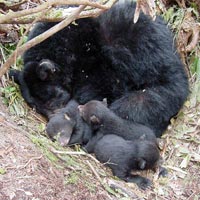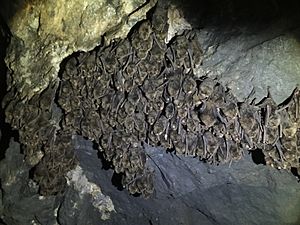Hibernation facts for kids

Hibernation is a time of inactivity. Some endothermic (warm-blooded) animals hibernate, usually during the winter, when food is short. They fall into a sleep-like state. They regulate their metabolism to consume less energy. They lower their body temperature, slow their breathing, and slow other vital functions. During hibernation, the body uses fat for energy, which the animal has gathered in summer and autumn.
Mammals like bats, ground squirrels (like marmots), hedgehogs, marsupials and others hibernate.
Many insects, such as the wasp Polistes exclamans, exhibit periods of dormancy which have often been referred to as hibernation. Some researchers use the term brumate to describe winter dormancy of reptiles.
Contents
Evolution of hibernation
As the ancestors of birds and mammals colonized land, leaving the relatively stable marine environments, more intense terrestrial seasons began playing a larger role in animals’ lives. Some marine animals do go through periods of dormancy, but the effect is stronger and more widespread in terrestrial environments. As hibernation is a seasonal response, the movement of the ancestor of birds and mammals onto land introduced them to seasonal pressures that would eventually become hibernation. This is true for all clades of animals that undergo winter dormancy; the more prominent the seasons are, the longer the dormant period tends to be on average.
Mammals
Primates
While hibernation has long been studied in rodents, namely ground squirrels, no primate or tropical mammal was known to hibernate until the discovery that the fat-tailed dwarf lemur of Madagascar hibernates in tree holes for seven months of the year. Malagasy winter temperatures sometimes rise to over 30 °C (86 °F), so hibernation is not exclusively an adaptation to low ambient temperatures. The hibernation of this lemur is strongly dependent on the thermal behaviour of its tree hole: if the hole is poorly insulated, the lemur's body temperature fluctuates widely, passively following the ambient temperature; if well insulated, the body temperature stays fairly constant and the animal undergoes regular spells of arousal. Dausmann found that hypometabolism in hibernating animals is not necessarily coupled to a low body temperature.
Bears
Hibernating bears are able to recycle their proteins and urine, allowing them both to stop urinating for months and to avoid muscle atrophy.
Obligate hibernation
Obligate hibernators are animals that spontaneously, and annually, enter hibernation regardless of ambient temperature and access to food. Obligate hibernators include many species of ground squirrels, other rodents, mouse lemurs, the European hedgehog and other insectivores, monotremes, marsupials, and even butterflies such as the small tortoiseshell. These undergo what has been traditionally called "hibernation": the physiological state where the body temperature drops to near ambient (environmental) temperature, and heart and respiration rates slow drastically. The typical winter season for these hibernators is characterized by periods of torpor interrupted by periodic, euthermic arousals, wherein body temperatures and heart rates are restored to euthermic (more typical) levels. The cause and purpose of these arousals is still not clear.
The question of why hibernators may experience the periodic arousals (returns to high body temperature) has plagued researchers for decades, and while there is still no clear-cut explanation, there are myriad hypotheses on the topic. One favored hypothesis is that hibernators build a 'sleep debt' during hibernation, and so must occasionally warm up in order to sleep. This has been supported by evidence in the Arctic ground squirrel. Another theory states that the brief periods of high body temperature during hibernation are used by the animal to restore its available energy sources. Yet another theory states that the frequent returns to high body temperature allow mammals to initiate an immune response.
Hibernating Arctic ground squirrels may exhibit abdominal temperatures as low as −2.9 °C, maintaining sub-zero abdominal temperatures for more than three weeks at a time, although the temperatures at the head and neck remain at 0 °C or above.
Historically there was a question of whether or not bears truly hibernate, since they experience only a modest decline in body temperature (3–5 °C) compared with what other hibernators undergo (32 °C or more). Many researchers thought that their deep sleep was not comparable with true, deep hibernation. This theory has been refuted by recent research in captive black bears.

Facultative hibernation
Unlike obligate hibernators, facultative hibernators only enter hibernation when either cold stressed, food deprived, or both. A good example of the differences between the two types of hibernation can be seen among the prairie dogs: the white-tailed prairie dog is an obligate hibernator and the closely related black-tailed prairie dog is a facultative hibernator.
Birds
Historically, Pliny the Elder believed swallows hibernated, and ornithologist Gilbert White documented anecdotal evidence in his 1789 book The Natural History of Selborne that indicated the belief was still current in his time. Birds typically do not hibernate, instead utilizing torpor. One known exception is the common poorwill (Phalaenoptilus nuttallii), first documented by Edmund Jaeger.
Dormancy in fish
Fish are cold-blooded, and so cannot hibernate because they cannot actively down-regulate their body temperature or their metabolic rate. However, they can experience decreased metabolic rates associated with colder environments and/or low oxygen availability (hypoxia) and can experience dormancy.
Brumation in reptiles
Reptiles are ectothermic (cold-blooded). Therefore cold temperatures would be deadly for them. Reptilian winter dormancy, or brumation, evolved to help reptiles survive colder conditions. We see today that reptiles that are dormant in the winter tend to have higher survival rates and slower aging.
Reptiles evolved to deliberately cool their internal body temperatures. As opposed to mammals or birds, which will prepare for their hibernation but not directly cause it through their behavior, reptiles will trigger their own hibernation through their behavior. Reptiles seek out colder temperatures based on a periodic internal clock, which is likely triggered by cooler outside temperatures, as shown in the Texas horned lizard (Phrynosoma cornutum).
In humans
Researchers have studied how to induce hibernation in humans. The ability to hibernate would be useful for a number of reasons, such as saving the lives of seriously ill or injured people by temporarily putting them in a state of hibernation until treatment can be given. For space travel, human hibernation is also under consideration, such as for missions to Mars.
Related pages
Images for kids
See also
 In Spanish: Hibernación para niños
In Spanish: Hibernación para niños



